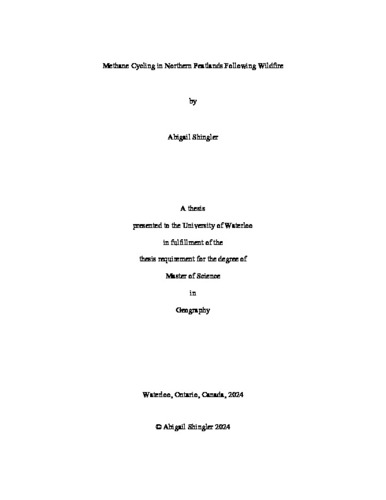| dc.contributor.author | Shingler, Abigail | |
| dc.date.accessioned | 2024-03-26 20:24:26 (GMT) | |
| dc.date.available | 2024-03-26 20:24:26 (GMT) | |
| dc.date.issued | 2024-03-26 | |
| dc.date.submitted | 2024-03-21 | |
| dc.identifier.uri | http://hdl.handle.net/10012/20405 | |
| dc.description.abstract | Peatlands are an important component of the global carbon (C) cycle, they operate as
long-term global sinks of atmospheric carbon dioxide (CO2) and sources of methane (CH4).
However, they are becoming increasingly vulnerable to disturbances such as wildfire.
Understanding the impact of wildfire on greenhouse gas dynamics is important as the
frequency and severity of these fires continues to increase. Loss of labile substrate and
methanogenic community is often attributed as the driver behind CO2 and CH4 emission
reductions from peatland soils post-wildfire. Soil incubations were conducted using samples
from both burned and unburned peatlands immediately (Alberta) and 2-years (Ontario) post fire to measure and compare CH4 production potential and oxidation. In-situ CH4 and CO2
flux measurements were conducted at the Alberta site immediately after fire. Environmental
variables such as water table depth, soil temperature and moisture were collected at each site.
Soil samples from the Ontario site were also analyzed for phenolic compounds, pH, and
electric conductivity.
In both the recently burned and 2-year post fire incubations, lower CH4 prodution was
observed at the burned sites. In-situ field fluxes determined that both ecosystem respiration
(ER) and net ecosystem exchange (NEE) was lower and CH4 flux indicated net CH4 uptake at
the burned site compared to the natural site, immediately post-fire. Overall, this study
enhances our understanding of the impacts of wildfire on greenhouse gas dynamics and
carbon storage in peatland ecosystems both immediately and 2-years post-burn. This
understanding is important for the establishment of peatland carbon budgets in response to
climate change, contributing to the development of accurate and reliable global carbon
budgets and climate modelling that can account for the increasing vulnerability of boreal
peatlands to fire. | en |
| dc.language.iso | en | en |
| dc.publisher | University of Waterloo | en |
| dc.subject | Methane | en |
| dc.subject | Peatlands | en |
| dc.subject | Canada | en |
| dc.title | Methane Cycling in Northern Peatlands Following Wildfire | en |
| dc.type | Master Thesis | en |
| dc.pending | false | |
| uws-etd.degree.department | Geography and Environmental Management | en |
| uws-etd.degree.discipline | Geography | en |
| uws-etd.degree.grantor | University of Waterloo | en |
| uws-etd.degree | Master of Science | en |
| uws-etd.embargo.terms | 0 | en |
| uws.contributor.advisor | Strack, Maria | |
| uws.contributor.affiliation1 | Faculty of Environment | en |
| uws.published.city | Waterloo | en |
| uws.published.country | Canada | en |
| uws.published.province | Ontario | en |
| uws.typeOfResource | Text | en |
| uws.peerReviewStatus | Unreviewed | en |
| uws.scholarLevel | Graduate | en |

